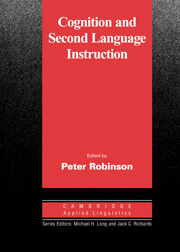Book contents
- Frontmatter
- Contents
- Series editors' preface
- Preface
- SECTION I THEORETICAL ISSUES
- 1 Attention
- 2 Memory for language
- 3 The competition model: the input, the context, and the brain
- 4 Sentence processing
- 5 Automaticity and automatization
- 6 Learnability and second language acquisition theory
- SECTION II COGNITION AND INSTRUCTION
- References
- Index
3 - The competition model: the input, the context, and the brain
Published online by Cambridge University Press: 05 October 2012
- Frontmatter
- Contents
- Series editors' preface
- Preface
- SECTION I THEORETICAL ISSUES
- 1 Attention
- 2 Memory for language
- 3 The competition model: the input, the context, and the brain
- 4 Sentence processing
- 5 Automaticity and automatization
- 6 Learnability and second language acquisition theory
- SECTION II COGNITION AND INSTRUCTION
- References
- Index
Summary
Introduction
Language learning is a three-way interaction between the input, the learner, and the interactional context (Bloom, 1974). This three-way interaction provides a general framework for understanding first and second language acquisition (SLA), in both naturalistic and formal contexts. In order to elaborate this general framework, we need to model its three components:
The input. We need to know how the linguistic input can be structured to maximize effective learning. What aspects of the phonology, syntax, semantics, and morphology of the input does the learner use to ‘crack the code’ of the new language?
The learner. We need to understand exactly how the cognitive abilities of the learner shape the process and outcome of L2 instruction.
The context. Traditionally, the classroom environment maintains a rather uniform structure in which interaction is controlled by the instructor. How does this framework affect learning and how can it be varied to improve the learning process?
This paper will examine these three components within the framework of the Competition Model (MacWhinney, 1987; MacWhinney & Bates, 1989). To quantify the role of the input in L2 learning, the model relies on the concepts of cue reliability and availability. To characterize the cognitive abilities of the learner, the model relies on findings from cognitive neuroscience. To understand the role of the context, the model elaborates the concepts of environmental and social support. The Competition Model views both L1 and L2 learning as constructive, data-driven processes that rely not on universals of linguistic structure, but on universals of cognitive structure.
- Type
- Chapter
- Information
- Cognition and Second Language Instruction , pp. 69 - 90Publisher: Cambridge University PressPrint publication year: 2001
- 79
- Cited by



